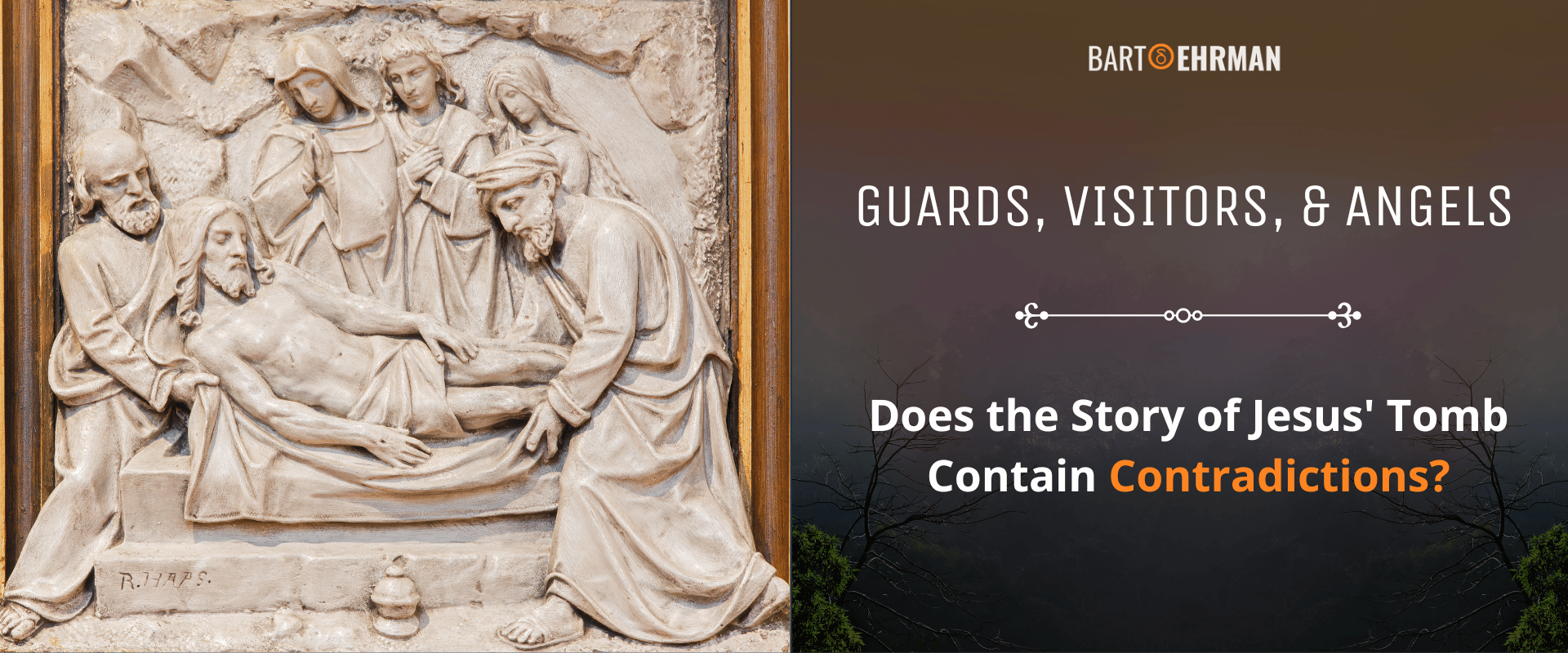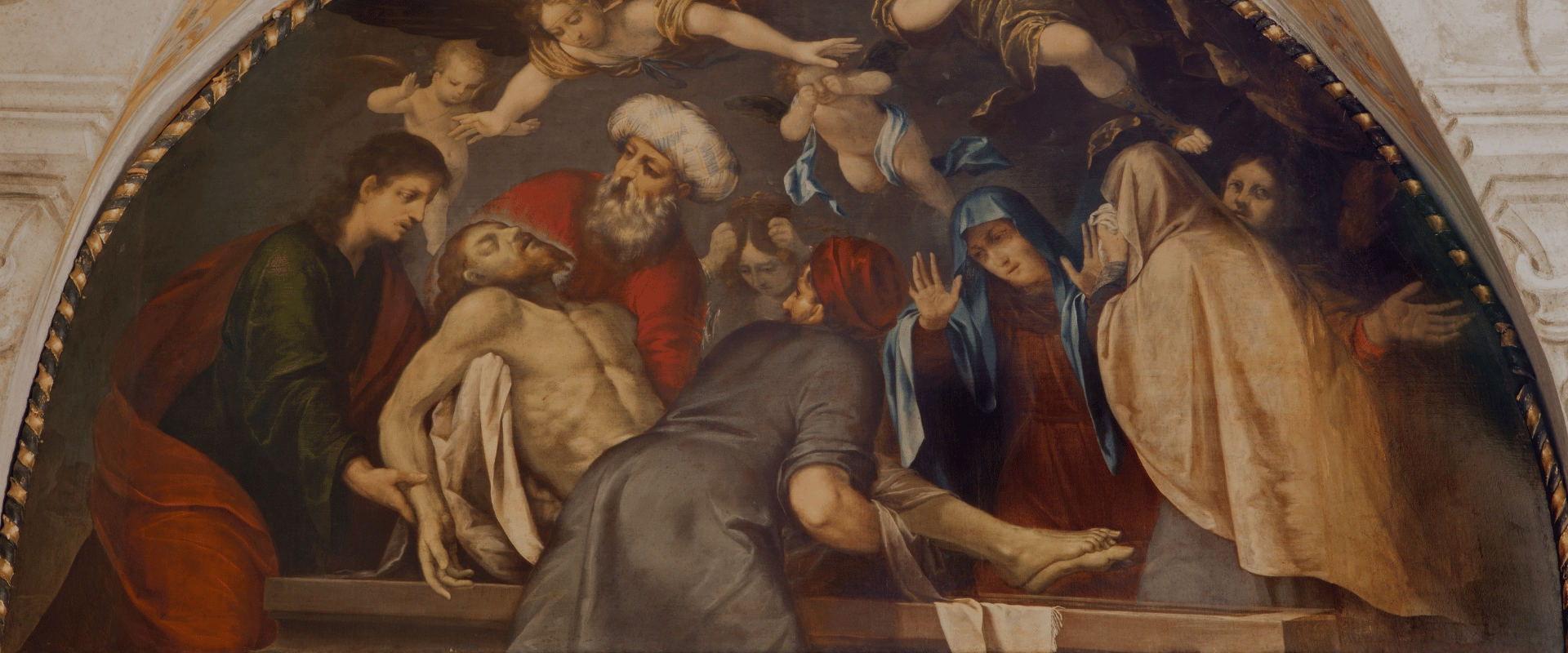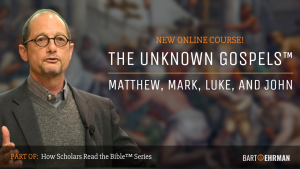Guards, Visitors, & Angels: Does the Story of Jesus' Tomb Contain Contradictions?

Written by Joshua Schachterle, Ph.D
Author | Professor | Scholar
Author | Professor | BE Contributor
Verified! See our editorial guidelines
Verified! See our guidelines
Date written: July 1st, 2024
Disclaimer: The views and opinions expressed in this article belong to the author and do not necessarily match my own. - Dr. Bart D. Ehrman
In a public lecture, Bart Ehrman said this about contradictions in Jesus’ tomb story:
Who went to the tomb on the third day? Was it Mary alone or was it Mary with other women? If it was Mary with other women, how many other women were there, which ones were they, and what were their names? Was the stone rolled away before they got there or not? What did they see in the tomb? Did they see a man, did they see two men, or did they see an angel? It depends which account you read.
The stories surrounding Jesus’ tomb in the Gospels are foundational to Christian belief, yet they present a challenge when examined side by side. Each Gospel offers its own version of events, raising questions about the discrepancies between them. From who discovered the empty tomb to the presence of angels or men at the scene, and even the reaction of those who found it, the contradictions in the Gospels are plentiful.
In this article, I’ll explore them in detail, examining each Gospel’s portrayal of the empty tomb story. By laying out the differences, I’ll highlight the complications of these foundational narratives and their significance within the broader context of ancient Christianity.
As a preview, I’ve made the following chart which points out some, but not all, of the contradictions in Jesus’ tomb story.
Incident | Mark 16:1-8 | Matthew 28:1-15 | Luke 24:1-12 | John 20:1-18 |
|---|---|---|---|---|
Who visited Jesus’ tomb? | Mary Magdalene, Mary the mother of James, and Salome (three women). | Mary Magdalene and the other Mary (two women). | Mary Magdalene, Mary the mother of James, Joanna, and other women (at least five women). | Mary Magdalene |
When and why did the women go? | Early on Sunday to anoint Jesus’ body with spices. | Sunday at dawn to see the tomb. | Sunday at dawn to take spices they’d prepared. | Before dawn on Sunday, doesn’t say why. |
What happens to the stone in front of the tomb? | Women worry about moving it, but find it already moved. | Women see an angel descend | Women find the stone rolled away. | Mary Magdalene finds the stone rolled away. |
How many guards were at the tomb? | None | At least two | None | None |
Who are the messengers at the tomb? | A young man in a white robe sitting inside on the right side of the tomb. | An angel dressed in dazzling white sitting on the stone outside the tomb. | Two men dressed in dazzling white clothing in the tomb. | Two angels inside the tomb where the body had been. |
How do the women react? | They fled from the tomb and told no one. | They left in fear and joy to tell the disciples. | They went to tell the disciples. | Mary went and returned with two disciples, Peter and the disciple whom Jesus loved. |
Does Jesus appear at the tomb? | No, Jesus never appears at all. | Sort of. Jesus appears to the two women as they are running from the tomb to tell the disciples. | No. | Jesus appears to Mary outside the tomb. |

Why Are There So Many Contradictions in the Gospels?
If the ancient authors of the Gospels were all telling the same story, why would they differ so much on the details? Think about stories you remember from growing up. Does anyone in your family remember them differently? Human memory is not entirely reliable, and the further we get from the events remembered, the less accurate those memories will likely be.
To complicate matters further, Ehrman points out that none of the Gospel authors were eyewitnesses to the life of Jesus. Instead, they were writing 35-60 years after Jesus’ death, dependent on oral and written traditions in a long game of telephone passed down through generations. As such, stories were surely changed over time.
As Ehrman says in his lecture,
Year after year, Christians trying to convert others told them stories to convince them that Jesus was raised from the dead. These writers are telling stories, then, that Christians have been telling all these years. Many stories were invented, and most of the stories were changed. For that reason, these accounts are not as useful as we would like them to be for historical purposes. They’re not contemporary, they’re not disinterested, and they’re not consistent.
Having established that there are multiple contradictions in the various Gospel stories of Jesus’ tomb, let’s explore the accounts one by one.
The Empty Tomb Story in the Gospel of Mark
I’m going to start this investigation with the Gospel of Mark, even though it’s the second Gospel in the New Testament. I’m doing this to look at the Gospel accounts in the chronological order in which they were written. Mark was written first, so let’s start there.
The first thing to know about Mark is that it has more than one ending. The first, which ends at Mark 16:8, is the original ending. There is then an intermediate ending, written by a different author or scribe, which adds on a bit to Mark 16:8. Finally, there is a longer ending, written by yet another author decades after the original. It conforms to what some of the other Gospels say about Jesus’ resurrection. For the purposes of this article, however, I’m going to stick with the original ending.
In Mark, three women — Mary Magdalene, Mary the mother of James, and Salome — come to Jesus’ tomb early on Sunday morning with spices in order to anoint his body. According to Krzysztof Pilarczyk, this was a Jewish burial custom which involved washing the corpse with warm water, anointing it with fragrant oils like myrrh and aloe vera — the “spices” mentioned — and placing it inside a shroud.
Since, according to Mark, Jesus’ body had been placed inside a rock-cut tomb by Joseph of Arimathea, it would have a huge, disc-shaped stone rolled over the entrance. In Mark, the women were worried they would not be able to move the stone in order to get inside the tomb. When they arrive, however, they see that the stone has already been rolled away from the entrance.
Entering the tomb, they see not Jesus but a young man (the Greek word is neaniskon, “youth”) wearing a white robe sitting in the tomb. Note that in Mark, he is not said to be an angel. Seeing the terror in their faces, the young man says “Do not be alarmed; you are looking for Jesus of Nazareth, who was crucified. He has been raised; he is not here. Look, there is the place they laid him. But go, tell his disciples and Peter that he is going ahead of you to Galilee; there you will see him, just as he told you.” We are never told who this young man is.
The very last verse of the original ending shows an understandable reaction by the women: “So they went out and fled from the tomb, for terror and amazement had seized them, and they said nothing to anyone, for they were afraid.” The Gospel ends there, with the terrified women telling no one about this encounter. There are no subsequent appearances of the risen Jesus.
Scholars have attempted to explain this abrupt ending in different ways. In A Brief Commentary on the Gospel of Mark, John Kilgallen writes that the mysterious ending fits with the overall theology of Mark in which even Jesus’ disciples never really understand him. By contrast, in the New Jerome Biblical Commentary, Raymond Brown speculates that Mark's audience already knew about Jesus' various appearances, making the author free to leave those out. Ultimately, there’s no way to know.
FREE COURSE!
WHY I AM NOT A CHRISTIAN
Raw, honest, and enlightening. Bart's story of why he deconverted from the Christian faith.
Over 6,000 enrolled!
The Empty Tomb Story in the Gospel of Matthew
Before going any further, it’s important to remember that while Mark is our oldest written Gospel, scholars know that Matthew and Luke used Mark as a source. However, Mark was not their only source, as evidenced by their more elaborate tomb stories.
Matthew’s resurrection account contains some of the same elements as Mark’s. For instance, while we have women going to Jesus’ tomb to anoint his body, In Matthew, there are only two, Mary Magdalene and “the other Mary,” with no further explanation for who this second Mary is.
However, Matthew’s version is much more dramatic than Mark’s. Matthew says that the chief priests and Pharisees were afraid that Jesus’ disciples would steal his body to create the appearance that Jesus had been raised from the dead. Accordingly, they asked Pontius Pilate to post guards at the tomb, which he did. When the women arrive at the tomb, an earthquake occurs apparently caused by an angel (Greek: angelos) who descends from heaven, rolls the stone away from the tomb entrance and sits on top of it.
The angel is dressed in dazzling white clothing, and upon seeing it, the guards shake in fear and pass out, becoming “like dead men.” The angel ignores them completely and addresses the women, telling them substantially the same message the young man gave in Mark’s Gospel: Jesus has been raised, so tell the disciples to meet him in Galilee.
Unlike in Mark, however, the women run to tell the disciples, but before they arrive, the risen Jesus appears to them. They worship him and he repeats the angel’s message. Meanwhile, the guards have awoken and told the chief priests what happened. The priests, not wanting this to get around, bribe the guards to tell people that they saw the disciples steal Jesus’ body, a story which Matthew says is still repeated in his day (roughly 50 years after Jesus’ death).
The Empty Tomb Story in the Gospel of Luke
Luke’s Gospel, again using Mark as a source like Matthew did, differs in some ways from both Mark and Matthew. In Luke, the number and names of women are not given initially. They are simply called “the women who had come with him from Galilee.” However, these unnamed and unnumbered women first go to Jesus’ tomb on Saturday to see his body. Because it is the Sabbath, they can’t do any work that day, including anointing Jesus’ body, so they leave and return on Sunday morning to do the job.
As in the Mark and Matthew, the women find the stone rolled away and, entering the tomb, find that Jesus’ body is gone. Suddenly, two men (Greek: andres) dressed in dazzling white clothes appear next to them. They tell the women Jesus has been raised, reminding them that Jesus said this would happen. In Luke, though, this is the end of their message. There is no command to go to Galilee to meet Jesus.
At this point, the Gospel names some of the women, including Mary Magdalene, Joanna, Mary the mother of James, and an unspecified number of “other women.” They run and tell the disciples who generally don’t believe the account. Peter, though, runs to the tomb anyway and sees Jesus’ burial cloths lying there. He is amazed but not yet comforted. Jesus does not appear at the tomb.

Empty Tomb Story in the Gospel of John
Having seen the differences between the empty tomb accounts in the Synoptic Gospels, let’s examine what the Gospel of John says. Since John is different in so many ways from the Synoptics, what happens at Jesus’ tomb?
Rather than have multiple women come to the tomb on Sunday morning like they did in the other three Gospels, John says it was Mary Magdalene alone. In addition, it doesn’t say she was there to anoint Jesus’ body. She just went to the tomb, her purpose unstated. By the way, the fact that Mary Magdalene is mentioned in all four Gospels tells us how important she was to early Christians.
When Mary arrives at the tomb, she sees that the stone has already been rolled away. Nevertheless, instead of entering, she runs to tell not all the disciples, but just Peter and “the disciple whom Jesus loved.” Even though John never says Mary went into the tomb, she somehow knows Jesus’ body is gone tells the two disciples, “They have taken the Lord out of the tomb, and we do not know where they have laid him.”
Peter and the other disciple set off at a run toward the tomb. The other disciple arrives first and looks in, seeing the empty linen wrappings from Jesus’ body. Peter, though, enters the tomb, seeing the same wrappings, and the cloth that was placed over Jesus’ face, rolled up and set to the side. The text says that the other disciple now entered the tomb and “saw and believed.” The two then depart, leaving Mary there, weeping outside the tomb.
When Mary bends down to look inside the tomb, she sees two angels (Greek: angelous) sitting where Jesus’ body had been. Apparently, they hadn’t been there a minute ago since Peter and the other disciple didn’t see them. The angels ask her why she’s crying and she repeats that they’ve taken away Jesus’ body, and she doesn’t know where to find him.
At this point, Mary turns around and sees a man standing there. It’s Jesus, although in his risen state, she doesn’t recognize him. Mary believes this man is the gardener and asks him if he has carried Jesus away, and to tell her where so she can take his body elsewhere. Jesus then says Mary’s name and she suddenly recognizes him, saying “Rabbouni!” which means “teacher” in Aramaic.
Jesus tells Mary not to touch him because he has not yet ascended “to my Father and your Father, to my God and your God.” Mary, overjoyed, goes and tells the disciples that she has seen the risen Jesus.
Conclusion
If you read the stories of Jesus’ empty tomb in all four Gospels, it’s clear that they disagree on many of the details. Was it an angel who spoke to the women? Two angels? A young man? Two young men? As Bart Ehrman says, it depends on which Gospel you read.
As I’ve mentioned in other articles, the Gospels were not written as history, or at least not what modern people mean by history. Instead, they were written as theology turned into narrative. This doesn’t mean that there are no historical facts in the Gospels, but that these ancient authors did not focus on historical accuracy.
The contradictions in Jesus’ tomb story reflect the vast stretch of time between the events described and the writing of the accounts. Each author was relying on both oral and written sources passed down over generations. As with any stories shared through time, changes, both intentional and unintentional, were made.

